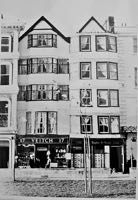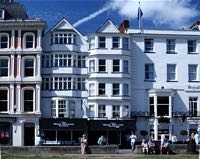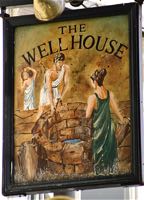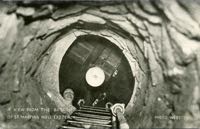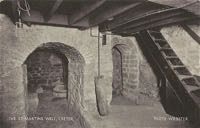
The Well House – 16-17 Cathedral Close
Page updated 1st January 2019
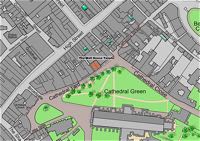 This pub belongs
to, and
is run by the Abode Group Royal
Clarence Hotel, to which it is adjacent. It is a popular public house,
situated in the heart of the Cathedral Close. Michael Caines, the
celebrity chef was responsible for the bar food from when it opened in early 2000 until he left the group, in early 2016.
This pub belongs
to, and
is run by the Abode Group Royal
Clarence Hotel, to which it is adjacent. It is a popular public house,
situated in the heart of the Cathedral Close. Michael Caines, the
celebrity chef was responsible for the bar food from when it opened in early 2000 until he left the group, in early 2016.
The Well House is in fact two premises, 16 and 17 Cathedral Yard. The fabric of the buildings are timber framed and date from the 16th and 17th Centuries, although there is Saxon stone work in the cellars, and a well that is probably Norman. Comprising of five stories, the left side has a gabled plaster front, with a single gable over each building. The left side has a Georgian bow window on the first floor, and splayed leaded oriel windows on the three floors above. Each storey of the right hand house from the first floor upwards has a cornice window across the width of the building. The wall that defined
Cathedral Yard runs through part of the rear of the building.
Social history
In 1861 no. 16 contained a retired tailor while no. 17 was a boot seller. No's 16 and 17 were a religious book seller in 1888. As was common then, and now, premises would change use quite frequently. In Kelly's 1897 Directory Charles William Priston was a tailor in no 16. In 1901 Sarah Buttishill is established as a dressmaker while no 17 is a bookshop. Kelly's 1914 Directory lists Haynes Ltd boot and shoe makers and dealers and in 1919 Babbage Gilbert & Co Solicitors. By 1923 No 16 was the home of Murray's Antiques. An announcement was made in May 1928 that G and N Hawkswell were to open a high class photographic studio at 16 Cathedral Yard, probably in an upper room.
A ship and a skeleton
In February 1934, model ships, including the Cruiser HMS Exeter, made by Ernest Oddy were exhibited at the Well House. The premises had recently come to prominence because of the recent discovery of the well, and a large cavity that contained a Roman bath–some dispute the dating and believe it is much later. Around three sides of the bath was a plinth, probably for tired Roman wives to sit. Pieces of Roman pottery and tiles, coins and some human skeleton remains were found.
By 1930 and up to the 1980's, No 17 housed Robert Veitch and Son
Ltd,
seedsmen. No 16 was an antique dealer and the Mocha Cafe in 1939, by 1959 it was James Commins, a bookseller, becoming R B Taylor and Sons, an estate agent by 1967.
It was in August 1984 that the Well House Tavern was opened by the Mayor, Jim Pollitt.
There is a stone stairway leading to the cellar beneath, where can be found the remains of an alleged victim of the Black Death, in an alcove. However, some historians believe the bones belong to a teenage, Anglo-Saxon–some authorities even think that the skeleton is made up of bones from a male and female. The cellar contains the remains of St Martin's Well, the source of the name, the Well House. Some think it of Roman origin, although the consensus is that it dates back to Norman times.
Fire – 28 October 2016
A fire was discovered at 5.30am in the Castle Gallery, 18, Cathedral Yard, next door to the Well House. In a short time the building was blazing, and by 10am, it was gutted, despite the best efforts of the Fire Service. It was thought the worst was over, until flames started leaping through the roof void of the Well House to the Royal Clarence. The fire fighters struggled to prevent it spreading ever further. By early afternoon, not only smoke could be seen from across the city, but flames leapt high into the sky. The fire burned through the afternoon and night, The fire was still burning on the morning of the 29 October. By lunch time, damping down was in progress, and structural engineers were assessing the safety of the front facade. Despite the buildings on three sides of the Well House being gutted, it looked as though the Well House had escaped the worst. Unfortunately, aerial photos taken by a police drone showed that the gable roof of the building had been badly damaged. Hopefully, restoration of the roof will see the Well House open again, in the not too distant future, but the damage around it was profound, and it is uncertain when and how the other buildings, including the much loved Clarence will be restored.
Sources: Historic England, The British Newspaper Archive, newspaper and TV reports on the 28 October.
│ Top of Page │
